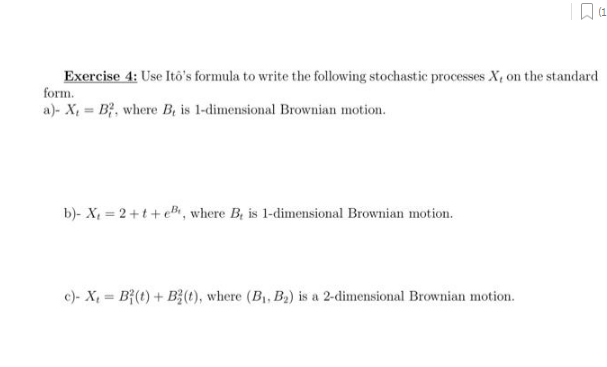Question
Suppose that the present day every day volatilities of asset A and asset B are 1.6% and 2.5%, respectively.The costs of the assets at close
Suppose that the present day every day volatilities of asset A and asset B are 1.6% and 2.5%, respectively.The costs of the assets at close of trading the day prior to this had been $20 and $40 and the estimate of the coefficient of correlation between the returns on the two belongings made at that time was zero.25. The parameter ? used inside the EWMA version is 0.Ninety five. (a) Calculate the cutting-edge estimate of the covariance among the assets. (b) On the idea that the fees of the assets at near of buying and selling today are $20.50 and $forty.50, replace the correlation estimate. Eleven.6 Suppose that the modern-day day by day volatilities of asset X and asset Y are 1.Zero% and 1.2%, respectively.The prices of the property at near of buying and selling the day prior to this have been $30 and $50 and the estimate of the coefficient of correlation between the returns on the two belongings made right now changed into 0.50. Correlations and volatilities are updated using a GARCH(1,1) version. The estimates of the model's parameters are ? = 0.04 and ? = 0.Ninety four. For the correlation ? = zero.000001 and for the volatilities ? = 0.000003. If the prices of the two belongings at close of trading nowadays are $31 and $fifty one, how is the correlation estimate up to date? 11.7 Suppose that in Problem 10.15 the correlation among the S&P 500 index (mea- sured in dollars) and the FTSE a hundred index (measured in sterling) is zero.7, the cor- relation between the S&P 500 index (measured in greenbacks) and the dollar-sterling trade charge is 0.Three, and the daily volatility of the S&P 500 index is 1.6%.What is the correlation between the S&P 500 index (measured in bucks) and the FTSE one hundred index whilst it is translated to bucks? (Hint: For 3 variables X, Y, and Z, the covariance among X + Y and Z equals the covariance between X and Z plus the covariance among Y and Z.) 11.8 Suppose that variables V1 and V2 have uniform distributions wherein all values among 0 and 1 are equally possibly.Use a Gaussian copula to define the correlation shape among V1 and V2 with a copula correlation of zero.Three. Produce a table much like Table 11.Five considering values of 0.25, zero.50, and 0.Seventy five for V1 and V2. (A [12:31 PM, 11/9/2021] vii: spreadsheet for calculating the cumulative bivariate everyday distribution is at the author's internet site: www-2.Rotman.Utoronto.Ca/?hull/riskman.) 11.9 Assume that you have independent random samples z1, z2, and z3 from a trendy everyday distribution and need to convert them to samples ?1, ?2, and ?3 from a trivariate regular distribution the usage of the Cholesky decomposition. Derive 3 formulation expressing ?1, ?2, and ?3 in phrases of z1, z2, and z3 and the three corre- lations which might be needed to outline the trivariate regular distribution. 11.10 Explain what is supposed by tail dependence. How are you able to range tail dependence by way of the choice of copula? 11.11 Suppose that the marginal distributions of V1 and V2 are wellknown regular distribu- tions however that a Student's t-copula with four degrees of freedom and a correlation parameter of zero.Five is used to outline the correlation among the variables. How would you bought samples from the joint distribution? 11.12 In Table eleven.5, what's the chance density feature of V2 conditional on V1



Step by Step Solution
There are 3 Steps involved in it
Step: 1

Get Instant Access to Expert-Tailored Solutions
See step-by-step solutions with expert insights and AI powered tools for academic success
Step: 2

Step: 3

Ace Your Homework with AI
Get the answers you need in no time with our AI-driven, step-by-step assistance
Get Started


